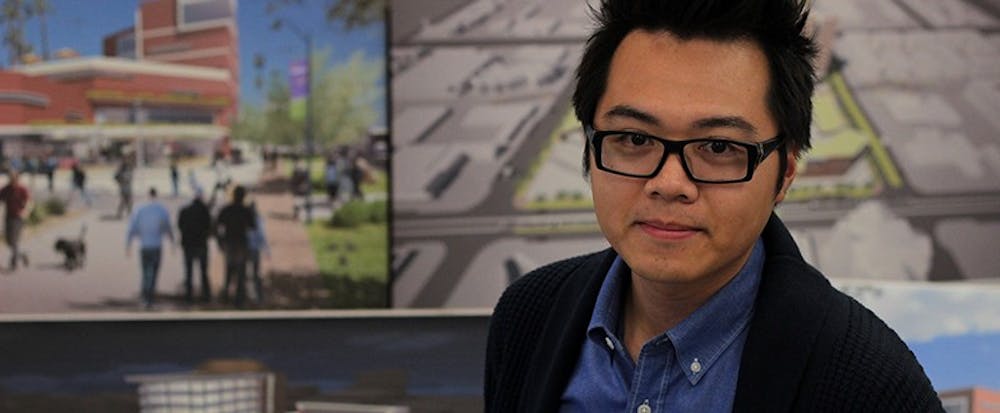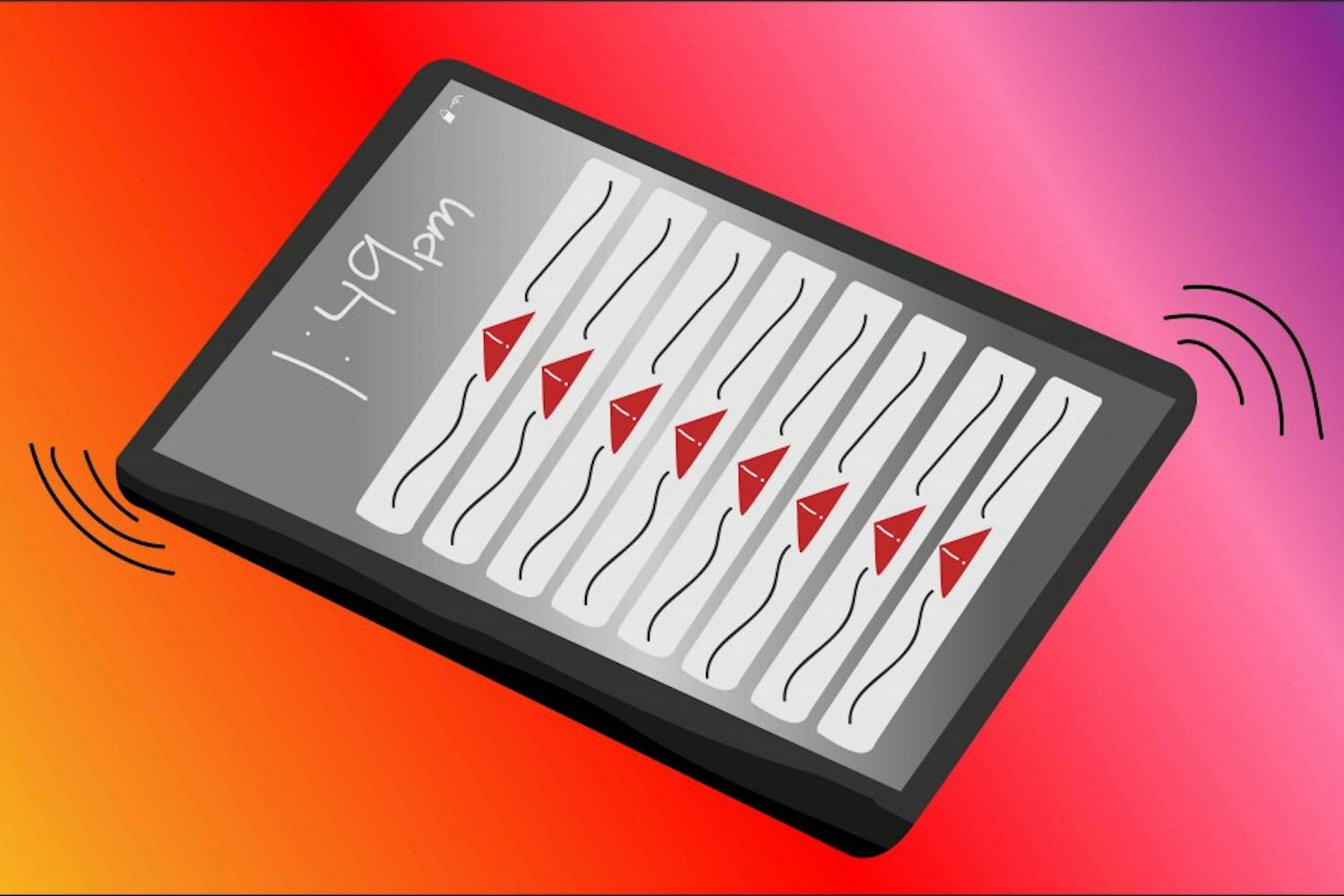 Architecture graduate student Guangyu “Sam” Cen poses with his group's designs of Mesa's new urban plaza. The group presented their designs with four other ASU teams to Mesa City Council members late last month. (Photo by Alexis Macklin)
Architecture graduate student Guangyu “Sam” Cen poses with his group's designs of Mesa's new urban plaza. The group presented their designs with four other ASU teams to Mesa City Council members late last month. (Photo by Alexis Macklin)
Four teams of ASU design students may see their visions for Mesa’s new urban plaza become a reality, after presenting their architectural designs to Mesa city council members late last month.
Mesa Mayor Scott Smith recruited the students, along with three professional design firms, to create a creative, innovative design that could accommodate at least 25,000 people. The need for the plaza arose after Mesa decided to expand the light rail system eastward, rendering the city’s normal event location, Main Street, unusable because the street will no longer be able to be blocked off.
Guangyu “Sam” Cen, an architecture graduate student and member of one of the groups, said his team’s trip to Rio de Janeiro in September provided valuable inspiration for highly populated spaces.
“We have to have experience to know what a high-density city looks like and how people are active, and how things happen in that area,” he said. “As a group, we all got different inspiration experience from there, and then we turned that into design practice.”
Other groups in Cen’s studio traveled to Japan, Australia and Argentina in the fall semester to study the unique architecture at those locations.
Each group presented unique features for the space, which will be used by the the professional design firms to make a feasible plan that combines the best of all the students’ plans. Some key features include interactive building displays that can be controlled by mobile apps on visitors’ phones, beautiful landscape designs and dramatic high rises, so visitors can look down on the plaza and the city.
Cen’s group’s design features what they call a “mist curtain” that comes down from a main bridge to cool and separate the plaza.
“The plaza is not just looking for events but also for flexible uses, so we were looking how to make a design with flexibility and sustainability, but at the same time celebrate the different energies around the area,” he said. “This idea comes from some local restaurants, some of the bars with the mist in summertimes. ... Within the mist curtain, it also creates a sort of atmosphere, so people can have events inside.”
He said the water from the curtain could be recycled and used for landscape irrigation to make the plaza more sustainable.
There was a fun sense of competition between the four ASU teams because of their dramatically different approaches, though they all gained valuable experience from the project, Cen said.
“I personally like architecture, because it's about creating something, and you can serve with your knowledge and social concerns for people who are pursuing their dreams, or for people in the city to have a better life,” he said. “This major helped me broaden my horizons and understand how the city works and how the world works, understand the world better and understand each other better.”
Nabil Kamel, who teaches urban planning, was one of the instructors who oversaw the project, along with David Pijawka and Edward Cook.
Kamel said he was proud of the students’ work and was pleased by the positive reactions of the council.
“I think based on the comments we got from city officials, as well as the community, ... (the designs) were exactly what they wanted, they were novel ideas and things to think about for their consultants who will continue the development,” he said. “What we gave the city was the kind of out-of-the-box thinking, cutting edge thinking that the city could consider when it comes to designing the plaza.”
Several students have already been asked by the city to help the consultants continue their designs, he said.
He also discussed the significant benefits the students gained from the real-world project.
“This was not like a typical design project, because their ideas will find their ways to the final solutions,” Kamel said. “These solutions, even though they were creative and innovative, they were also realistic and feasible. The students, who were used to hypotheticals, they could see how real-life urban designs can appeal to a diverse community, and they succeeded in that because there was a positive reaction from the audience.”
Among the council members in the audience was Dennis Kavanaugh, who represents the third district, or the western edge of Mesa.
He said the day he heard the students’ presentations, Jan. 14, was dramatically changed by the students’ enthusiasm.
“It started a mid-afternoon in a day that was long and tiring,” Kavanaugh said. “As each group came up and spoke, you get caught up in seeing that tired space I see every day and looking at it through different glasses at what the students created. It was an uplifting experience. It definitely woke me up!”
He said now that the designs have been presented, it’s up to the professional design firms to combine the best ideas and create a plan that can be budgeted and implemented into the real world.
“The teams set a really high bar for the consulting companies, because they're going to have to come back with something really exciting to compare with the student projects to engage the staff and community,” Kavanaugh said. “If I were one of the pros, I’d have taken a big gulp when I looked at the projects.”
Although the design stage had definite funding from the city, no funds have yet been allocated for the implementation. Kavanaugh said this will be the next challenge, as the city of Mesa must find funding for the urban plaza from the voters, bonds, or other means. He estimated it will be two to four years until the plaza is complete.
Despite the coming struggles, Kavanaugh praised the ingenuity of the ASU design students and looked forward with excitement to the realization of Mesa’s urban plaza.
“(I was) blown away, because each of the groups presented novel designs for what I thought was an undevelopable site, and taking an expanse of concrete and parking, a wasteland between buildings, and have presented concepts that were very adventurous and fun,” he said. “Obviously, their expertise in the fields that they're studying showed in the outcome we saw.”
Reach the reporter at elmahone@asu.edu or follow her on Twitter @mahoneysthename




